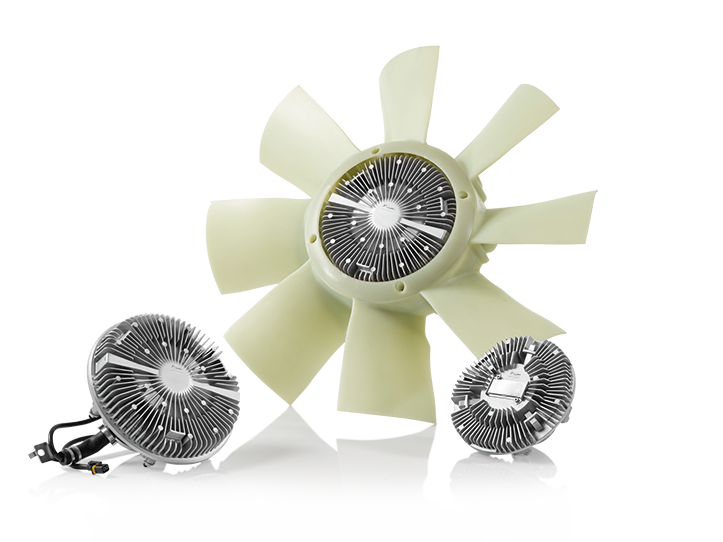The 9-Second Trick For Fan Clutches
Table of ContentsAbout Fan ClutchesFan Clutches Things To Know Before You Get ThisFan Clutches - TruthsExcitement About Fan Clutches
Engine fan with thick drive A fan clutch is a thermostatic engine cooling fan that can freewheel at low temperature levels when cooling is not required, enabling the engine to warm up quicker, relieving unneeded load on the engine. As temperature levels increase, the clutch engages so that the fan is driven by engine power and moves air to cool the engine.This conserves power, because the engine does not have to completely drive the fan. Nevertheless, if engine temperature rises above the clutch's engagement temperature level setting, the fan becomes fully engaged, hence drawing a higher volume of ambient air through the lorry's radiator, which in turn serves to preserve or decrease the engine coolant temperature to an appropriate level.
This is easier to achieve since the engine is mounted longitudinally, with the belt accessory components mounted dealing with the radiator. The fan is mounted on the crankshaft pulley-block or among the accessory wheels (e. g. the water pump wheel) and will spin in between the radiator and the engine, drawing air back through the radiator and blowing it over the engine.
On the other hand, in a front-wheel drive automobile, the engine is normally mounted laterally, with the crankshaft and normally all the major device shafts parallel to the front axle, so as to straight drive the transaxle; a fan mechanically installed on an accessory wheel would blow sideways and would not face the radiator.
The conversion of power to electrical energy and back to mechanical rotary power with a fan motor is less effective than a direct mechanical connection, however this is more than compensated by greater control of an electrical fan through electronic thermostatic controls which can turn the fan completely off when the engine temperature is listed below the setpoint.
The Best Guide To Fan Clutches
Some clutches are digitally controlled (instead of bi-metallic strip). These offer the potential to manage the level of engagement depending on any number of inputs. Typical controlling aspects may include engine oil temperature, transmission oil temperature level, coolant temperature, Air Conditioner system pressures and ambient air temperature.
When you think about an automotive cooling system, the first thing that likely comes to mind is your radiatoror perhaps your cooling fan. The oft-overlooked doesn't get a heap of credit or attention, but it's an essential piece of the cooling formula in many vehicles. It assists your cooling system run efficiently and your engine operate effectively.
A fan clutch is a temperature-controlled coupling in between the water pump shaft and the fan which allows the fan to be operational at low speeds and disconnected at greater speeds. This permits the engine to run more click for info effectively by eliminating the load that the fan put on it. So how does it work? It really depends on the design of fan clutch you choose.
Non-thermal clutches operate entirely based on the shaft speed of the water pump. At low and idling speeds, the clutch allows the fan blade to turn at nearly a 1:1 ratio. At high speeds, the silicone fluid within in the clutch will lose its ability to transfer the energy from the shaft to the fan clutch body (and for that reason, the fan) and the fan is then enabled to site web almost free-wheel, removing its load from the engine.
Nevertheless, non-thermal clutches are a lower-cost choice than thermal-style clutches. The thermal fan clutch operates in action to underhood temperature levels. As hot air blows throughout the radiator, it heats a thermal spring installed at the front of the clutch. As the spring is warmed, it turns and permits valve ports to open within the clutch.
How Fan Clutches can Save You Time, Stress, and Money.

This fan design turns the fan at 70-90 percent of the shaft speed when engaged for increased cooling. When disengaged, it turns the fan at 25-35 percent. It's used with deeper-pitch fans (2Â 1/2 of pitch), and works well with greater operating rpm. Severe duty thermal fans turn the fan at 80-90 percent of the shaft speed when engaged and 20-30 percent when disengaged.
This style of fan clutch operates like a thermal clutch, but the ECM/PCM signal manages the level of engagement of the EV clutch. fan clutches. This engagement process is ultimately controlled through the ECM/PCM by the following input variables: Coolant Temperature, Consumption Manifold Temperature, Transmission Oil Temperature, A/C Pressure and Engine Oil Temperature.
Like all parts, fan clutches will wear out and need changed. According to Hayden, here are some indications your fan clutch might need changed: Fan spins exceedingly when engine is stopped (3 or more times when hot engine read this article is shut off). Poor A/C performance at idle or low car speeds.


Fan Clutches Things To Know Before You Buy

The Fan Clutch is a crucial part of your cooling system. Its drive shaft connects to the water pump. Then, the fan connects to the clutch real estate. The fan clutch's job is to manage when the fan comes on and off. It offers airflow when needed. It likewise decreases drag on the engine when not required - fan clutches.